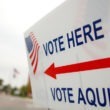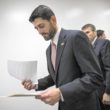The New Financial Economy—In 1948, 56 percent of profits in the U.S. economy derived from manufacturing, while 8.3 percent came from the financial sector. In 2007 (the year the financial collapse began) manufacturing produced 10 percent of profits, while the financial sector produced 26 percent of profits.
The $62 Trillion Question—Eighteen months ago, Iowa Democratic Senator Tom Harkin was framing testimony for the Senate Agriculture Committee. Harkin chairs the committee. The subject was credit default swaps, the complex financial instruments that pushed the global economy to the precipice of depression. Harkin ran the numbers. The Dow Jones Industrial Average had lost 40 percent of its value during the previous year. Measured in dollars, the Wilshire Broad Index had lost $8.4 trillion. Upon the request of President Bush, the Congress had spent $700 billion to prop up the collapsing economy.
“Credit default swaps weren’t around before the early 1990’s [and] ballooned in the 2000’s,” Harkin said. (They “ballooned” after a 250-page amendment—written by Wall Street lawyers, sponsored by Republican Senator Phil Gramm, and backed by Clinton Treasury Secretary Robert Rubin—was discretely tacked on to an appropriations bill as Congress was adjourning for Christmas in 2000. One provision in the amendment exempted CDSs from regulation.)
Harkin explained that mortgage lenders began bundling and selling mortgages in the 1980’s, and that buyers of the securitized mortgages bought credit default swaps as insurance policies in the event that the bundled mortgages were to default. Because the insurance swaps were unregulated, there was no way of knowing whether the insurer could pay off in the event of default.
Harkin also defined “naked default swaps,” in which a party who doesn’t own a security buys a policy on it, betting on it either to fail or succeed. “They just bet that either it will be okay or will not be okay,” Harkin said. “Then Wall Street comes in and sells them kind of an insurance policy made on that bet.”
When the U.S. financial system collapsed in 2008, with Lehman Brothers going bankrupt and threatening to take insurance combine AIG with it, an estimated $62.2 trillion in CDS value was hanging out there—a figure equivalent to the gross domestic product of the world in 2008.
Because CDSs are unregulated, there was no way of knowing what capital reserves backed them. An estimated 80 percent of that $62.2 trillion was in naked swaps, directional bets in which the parties owned no interest in the securities they were insuring. And 80 percent of all credit default swaps are traded by the nation’s five biggest investment banks—their losses backed by the FDIC and U.S. Treasury.
That in 300 words is the case for regulation, which all 41 Senate Republicans have vowed to oppose as a Senate finance regulation bill moves to the floor. And default swaps are only one critical piece of the regulation package.
Swap Fraud at Goldman Sachs—In mid-April, the Securities and Exchange Commission alleged that investment bank Goldman Sachs used credit default swaps to defraud clients of $1 billion. According to the SEC complaint, Goldman bundled mortgages that were calculated to lose value, sold them to clients, then purchased credit default swaps on the securitized mortgages. When the value of the “synthetic collateralized debt obligation” packages that Goldman sold their clients tanked, Goldman cashed in on the swaps, collecting billions. Goldman Sachs used a separate entity, Abacus 2007-AC1, similar to the offshore entities used by Enron, to sell the investment packages the SEC alleges were designed to fail. According to the New York Times reporting on Goldman’s dealings, seven of the Abacus deals were insured by credit default swaps purchased from AIG, the insurance giant the federal government bailed out with an initial $180 billion in Troubled Assets Relief Program funding. Goldman Sachs denies the charges.
Two Trillion Dollars—That’s the total amount of the bank bailout, including TARP, Federal Reserve and Treasury Department spending, according to Ted Kaufman, a placeholder Senator serving out Joe Biden’s term. “And that amount included neither the many trillions of dollars committed as guarantees for toxic debt, nor the de facto bailout that banks received through the Federal Reserve’s easing of monetary policy,” Kaufman said in March. His solution, reinstating regulatory provisions that would ban commercial banks from speculative investment, isn’t on the table.





0 Comments